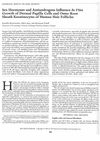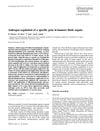 37 citations
,
November 1995 in “Journal of Investigative Dermatology”
37 citations
,
November 1995 in “Journal of Investigative Dermatology” Topical finasteride and flutamide reduce gland size and enzyme activity, with flutamide being more potent, potentially treating acne, seborrhea, hirsutism, and androgenic alopecia.
 40 citations
,
January 1994 in “Skin Pharmacology and Physiology”
40 citations
,
January 1994 in “Skin Pharmacology and Physiology” Male hormones affect oil-producing skin cells differently based on their body location, and the drug spironolactone can reduce these effects.
9 citations
,
July 1993 in “The journal of investigative dermatology/Journal of investigative dermatology” Sex hormones and antiandrogens can either stimulate or inhibit human hair follicle cell growth depending on the dose.
 12 citations
,
July 1993 in “The journal of investigative dermatology/Journal of investigative dermatology”
12 citations
,
July 1993 in “The journal of investigative dermatology/Journal of investigative dermatology” Certain sex hormones and antiandrogens can either slow down or speed up the growth of human hair follicle cells depending on their concentration.
9 citations
,
October 1991 in “Archives of Dermatological Research” Testosterone, DHT, and estradiol significantly affect hair cell growth.
 12 citations
,
January 1991 in “Archives of dermatological research”
12 citations
,
January 1991 in “Archives of dermatological research” Male hormones control a specific gene in hamster skin, with different hormones having varying effects.
69 citations
,
August 1988 in “Journal of Investigative Dermatology” 15 citations
,
June 1986 in “Pediatric Dermatology” Androgens increase pigmentation in young hamsters, but estrogens can reverse this effect.
25 citations
,
November 1979 in “International Journal of Dermatology” Androgens affect skin conditions like acne and hair loss through specific biochemical pathways.



